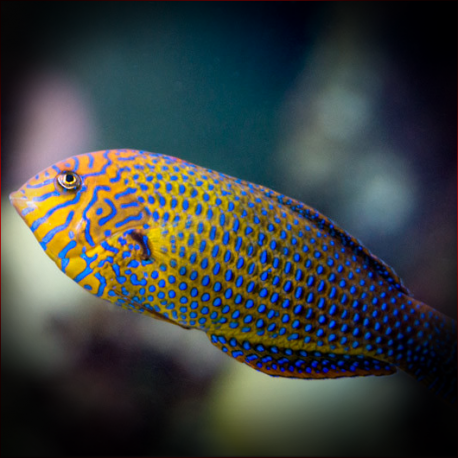More info
Datasheet
| Minimum Tank Size | 264 litres / 69.74 US gallons |
| Maximum Size | 11.4cm / 4.49inches |
| Reef Compatible | Yes |
| Temperament | Peaceful |
| Care Description | Expert Only |
| Specific Gravity | 1.020-1.025 |
| Carbonate Hardness | 8-12 |
| pH | 8.1-8.4 |
General Description
The Potter's Leopard Wrasse, also known as Geoffroy's Wrasse or Shortnose Wrasse, boasts an orange-peach body adorned with striking blue markings, adding a vibrant aesthetic to any aquarium setting.
Aquarium Suitability
With a requirement of a 50-gallon tank or larger, this species thrives in environments with peaceful tank mates and well-established live rock and sand. Being carnivorous, they feed on small invertebrates like copepods and amphipods, emphasizing the need for an appropriate tank setup.
Demands
Due to its specific care needs, the Potter's Leopard Wrasse is recommended for experienced aquarists, earning the classification of "Expert Only."
Care and Hardiness
To ensure the well-being of the Potter's Leopard Wrasse, it should be housed in an aquarium with a minimum of a two-inch layer of fine sand, allowing them to bury themselves for protection during the night. Maintaining stable water conditions with a pH ranging from 8.1 to 8.4, a dKH of 8-12, and a salinity between 1.020-1.025 is crucial for their health.
Reef Suitability
This species is suitable for reef aquariums, making it a versatile addition for aquarists interested in keeping both fish and coral.
Aquarium Setup
Creating an ideal habitat for the Potter's Leopard Wrasse involves incorporating plenty of live rock and sand. Their diet should consist of enriched frozen mysis and brine shrimp, black worms, and other carnivorous preparations, offered multiple times throughout the day in small quantities.
Behaviour
Known for their peaceful temperament, these wrasses are an excellent choice for community tanks with equally docile tank mates.
Feeding and Diet
Being carnivorous, the Potter's Leopard Wrasse thrives on a diet rich in enriched frozen mysis and brine shrimp, along with other carnivorous offerings. Feeding them three to four times a day ensures they receive the necessary nutrition.
Dimorphism
The species Macropharyngodon geoffroyi exhibits dimorphism, showing differences between male and female specimens. In captive settings, successful reproduction of the Potter's Leopard Wrasse can be achieved with proper care and breeding conditions.
Habitat and Distribution
Found in various marine habitats, these wrasses are native to specific regions and thrive in the sandy substrates of the tropical waters they inhabit.

